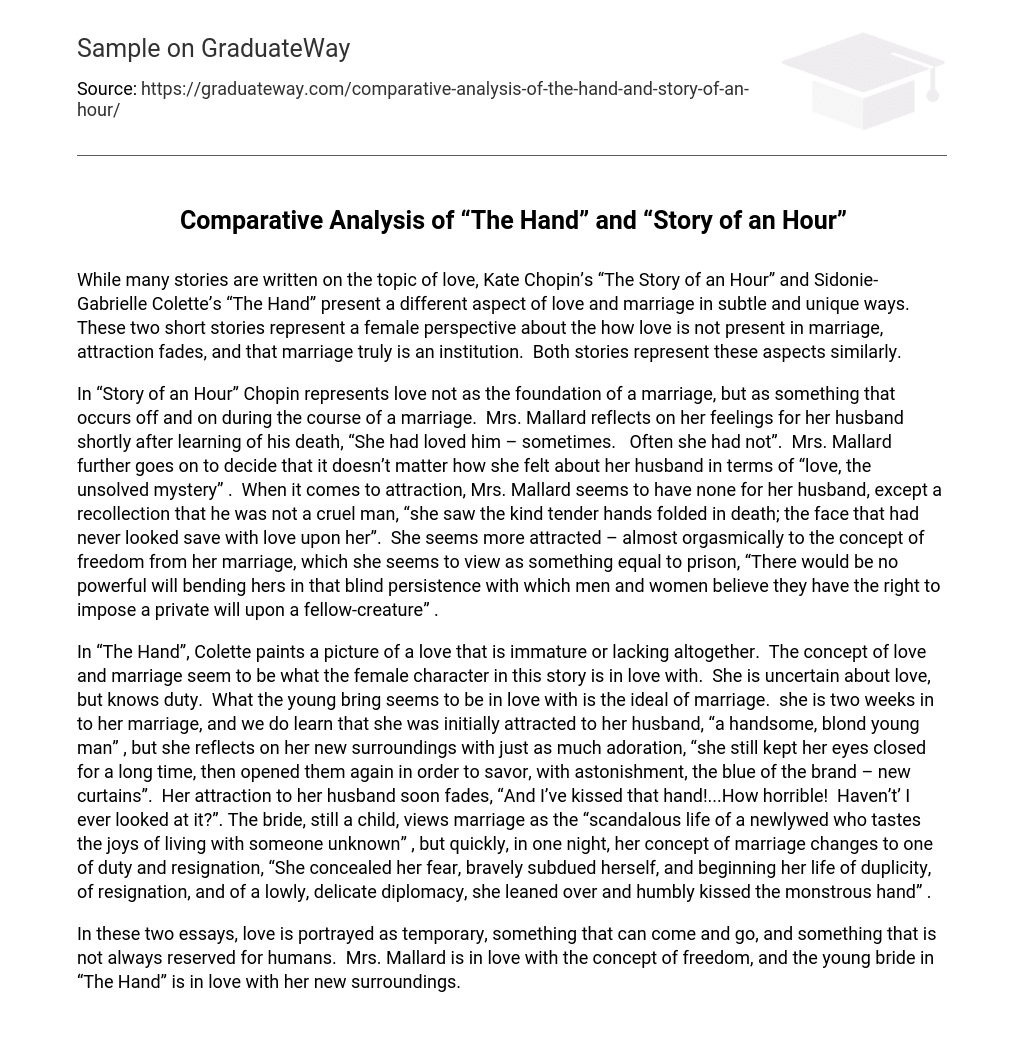While many stories have been written on the topic of love, Kate Chopin’s “The Story of an Hour” and Sidonie-Gabrielle Colette’s “The Hand” present a unique perspective on love and marriage. These two short stories provide insight into how love may not always be present in marriage, how attraction fades over time, and that marriage is truly an institution. Both stories represent these aspects in subtle yet similar ways from a female perspective.
In Story of an Hour,” Chopin portrays love not as the foundation of a marriage, but rather as something that ebbs and flows throughout the course of a marriage. Mrs. Mallard reflects on her feelings for her husband shortly after learning of his death: “She had loved him – sometimes. Often she had not.” Mrs. Mallard goes on to decide that how she felt about her husband in terms of “love, the unsolved mystery” did not matter. In terms of attraction, Mrs. Mallard seems to have none for her husband except for a recollection that he was not a cruel man: “she saw the kind tender hands folded in death; the face that had never looked save with love upon her.” She appears more attracted – almost orgasmically – to the concept of freedom from her marriage, which she views as equivalent to prison: “There would be no powerful will bending hers in that blind persistence with which men and women believe they have the right to impose a private will upon a fellow-creature.”
In The Hand,” Colette portrays a love that is immature or lacking altogether. The female character in this story seems to be in love with the concept of love and marriage. Although uncertain about love, she knows duty well. What the young bride seems to be in love with is the ideal of marriage. She has been married for only two weeks, and we learn that she was initially attracted to her husband, “a handsome, blond young man.” However, she reflects on her new surroundings with just as much adoration: “She still kept her eyes closed for a long time, then opened them again in order to savor, with astonishment, the blue of the brand-new curtains.” Her attraction to her husband soon fades: “And I’ve kissed that hand!… How horrible! Haven’t I ever looked at it?”
The bride views marriage as the scandalous life of a newlywed who tastes the joys of living with someone unknown but quickly changes her concept of marriage to one of duty and resignation in just one night: “She concealed her fear, bravely subdued herself and began her life of duplicity, resignation and lowly delicate diplomacy by leaning over and humbly kissing his monstrous hand.”
In these two essays, love is portrayed as temporary and something that can come and go. It is not always reserved for humans. Mrs. Mallard falls in love with the concept of freedom, while the young bride in “The Hand” falls in love with her new surroundings. Attraction fades over time and is not necessary for a successful marriage; it is only a fleeting emotion that arises during moments of weakness. Marriage is depicted as a condition similar to imprisonment, where submission and hope are the only ways to make it through.
Works Cited
- Chopin, Kate. The Story of an Hour.” The Compact Bedford Introduction to Literature, 5th ed., Michael Meyer (ed.), Bedford: Boston, 2000, pp. 10-12.
- Colette, Sidonie-Gabrielle. “The Hand.” The Compact Bedford Introduction to Literature, 5th ed., Michael Meyer (ed.), Bedford: Boston, 2000, pp. 196-198.





